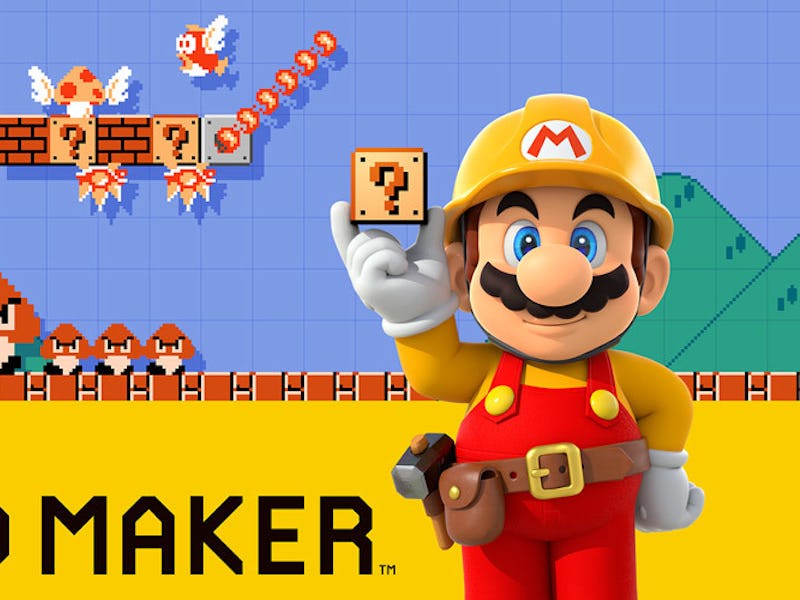'Super Mario Maker' And the User-Generated Content Playground
In some games, the players are able to play god.

Super Mario Maker, released today, is about to become the greatest Mario game you never knew you wanted. All those years spent running right to eat magic mushrooms and save the Princess have prepared you for this moment: making your own Mushroom Kingdom.
By far the greatest gift the internet has given our species is collaboration. Sharing work over thousands of miles away has made our big world just a wee bit smaller and intimate.
Video games have evolved with sandbox creation tools faster than any other form of entertainment. Players were modding Doom way before YouTube and Joseph Gordon-Levitt’s collaborative filmmaking platform hitRECord. But Super Mario Maker, which comes as a ready-to-tinker toolbox, seems exactly what we have been getting to all along.
It began with modding PC games in the early ‘90s, a hobby equal to automotive geeks tricking out their cars but way dorkier, and continues to thrive today. Entirely new games like Team Fortress were crafted from ripping apart Quake — like making Eve out of Adam’s rib (that shit’s sexist, btw). In recent years, dozens of games have included robust creation spaces within the games themselves.
SimCity from 1989 is probably the most popular, earliest example of built-in sandbox creation. Taking cues from 1984’s Raid on Bungeling Bay, SimCity allowed you to forge thriving metropolises or watch them collapse under chaos. It wouldn’t be until 1996’s SimCity 2000 (when everything in the late ‘90s had “2000” in its title) that allowed players to share among themselves.
In 2002, BioWare released Neverwinter Nights, a fantasy RPG based on Dungeons & Dragons. Within the game was the Aurora toolset, which allowed players to create single- and multiplayer quests, cutscenes, tech demos, and all other kinds of neat stuff.
Here’s a drunk guy talking about it on YouTube.
In 2007, Bungie responded to Halo’s massive modding community (the very same that spawned the popular web series Red vs. Blue) by introducing The Forge, an in-game sandbox for Halo 3 multiplayer.
By working with a “budget,” an empty map, and a really unique camera first-person camera tool, Halo players stopped shooting each other and worked together to create custom maps and entirely new game-types that kept them playing long after they completed the main campaign.
During filming for a video, the makers of Red vs. Blue were dicking around in Forge and invariably invented “Grifball,” which has since been implemented into Halo as an official game-type.
The WWE games throughout the years have earned a reputation for their wide-open sandbox tools. It began with custom wrestlers, which were quickly used to fill the games’ rosters to make them as up-to-date as possible, or to play out impossible fantasy matches.
In 2011, this concept was taken to the extreme with WWE All-Stars.
In 2011, WWE 2012 allowed for the first time custom wrestling arenas that fans can upload and share online. It was really just a lot of pixel swapping, but if you wanted a New Japan Pro Wrestling ring in a WWE game, this was it.
That same year, Valve released Portal 2, which included a comprehensive level editor. For a 3D first-person puzzle game built on the premise of inter-spacial teleportation, it was wild.
In 2009, the alpha version of Minecraft was released before its complete release in 2011. It currently stands as one of the most successful video games of all time, and it’s all about building.
2008’s FarCry 2 and 2012’s Far Cry 3 included map editors that a few on Reddit called “underrated.”
The side-scrolling LittleBigPlanet is a franchise spanning several titles that are built entirely on the premise of user-generated content. Exclusive to PlayStation systems, the games were a hit in part due to the creativity demanded of the player and because of just how adorable Sackboy is.
And really, Super Mario Maker isn’t Nintendo’s first foray into custom, user-generated content. In 2008’s Super Smash Bros. Brawl, the stage creator allowed players to make custom battle arenas that were shared and uploaded online. The Wii wasn’t a great online system and downloading took forever, but it was an early precursor of what was to come.
Coming full circle, next year’s Doom reboot from Bethesda is including a major sandbox tool, SNAPMAP. Essentially Halo 3’s Forge, SNAPMAP will let Doom players get as creative as they were making mods over 20 years ago.
More fun than playing in the worlds the designers work to build are the wacky stuff fans come up with for shits and giggles. They know these games better than anyone, so leave it to them to create hilariously difficult or just plain ingenious level designs.
Super Mario Maker just came out, and it’s already being flooded with the kind of genius stuff you could expect.
It’s a dream of any kid who grew up on a diet of Nintendo games to forge their own Super Mario levels. On Super Mario’s 30th anniversary, it’s now time to nut up, shut up, and get to work.